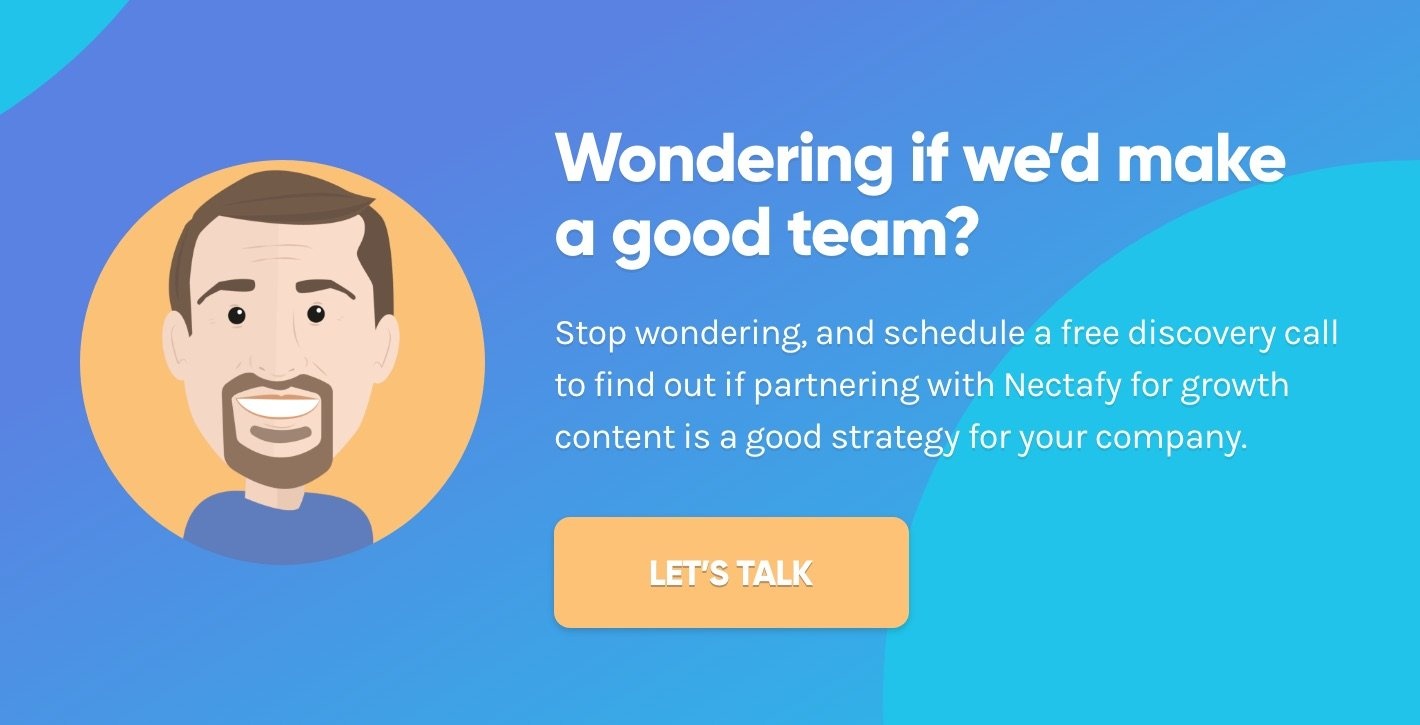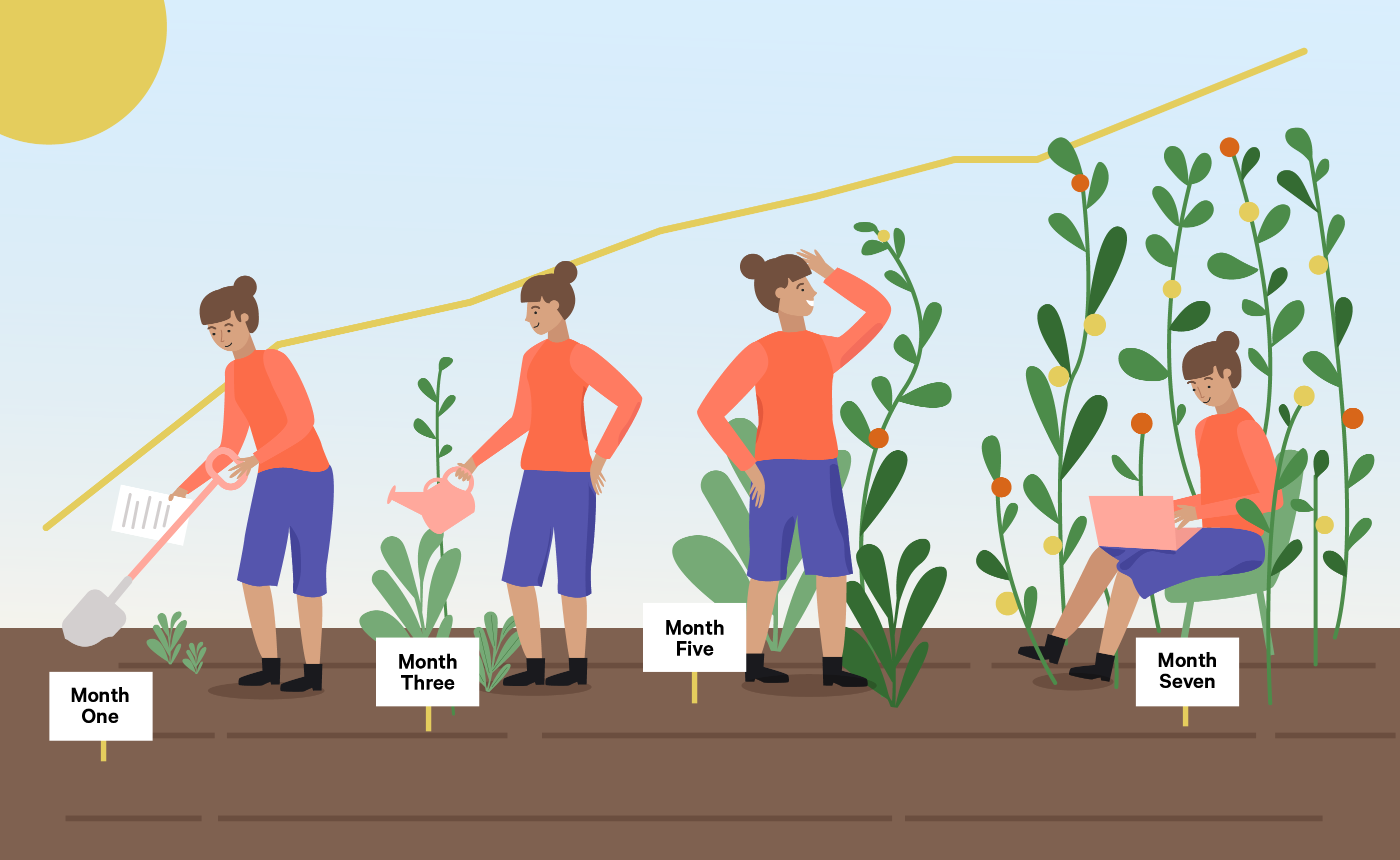From 600 to 6,000 Organic Visits In 12 Months: The B2B Blog Strategy
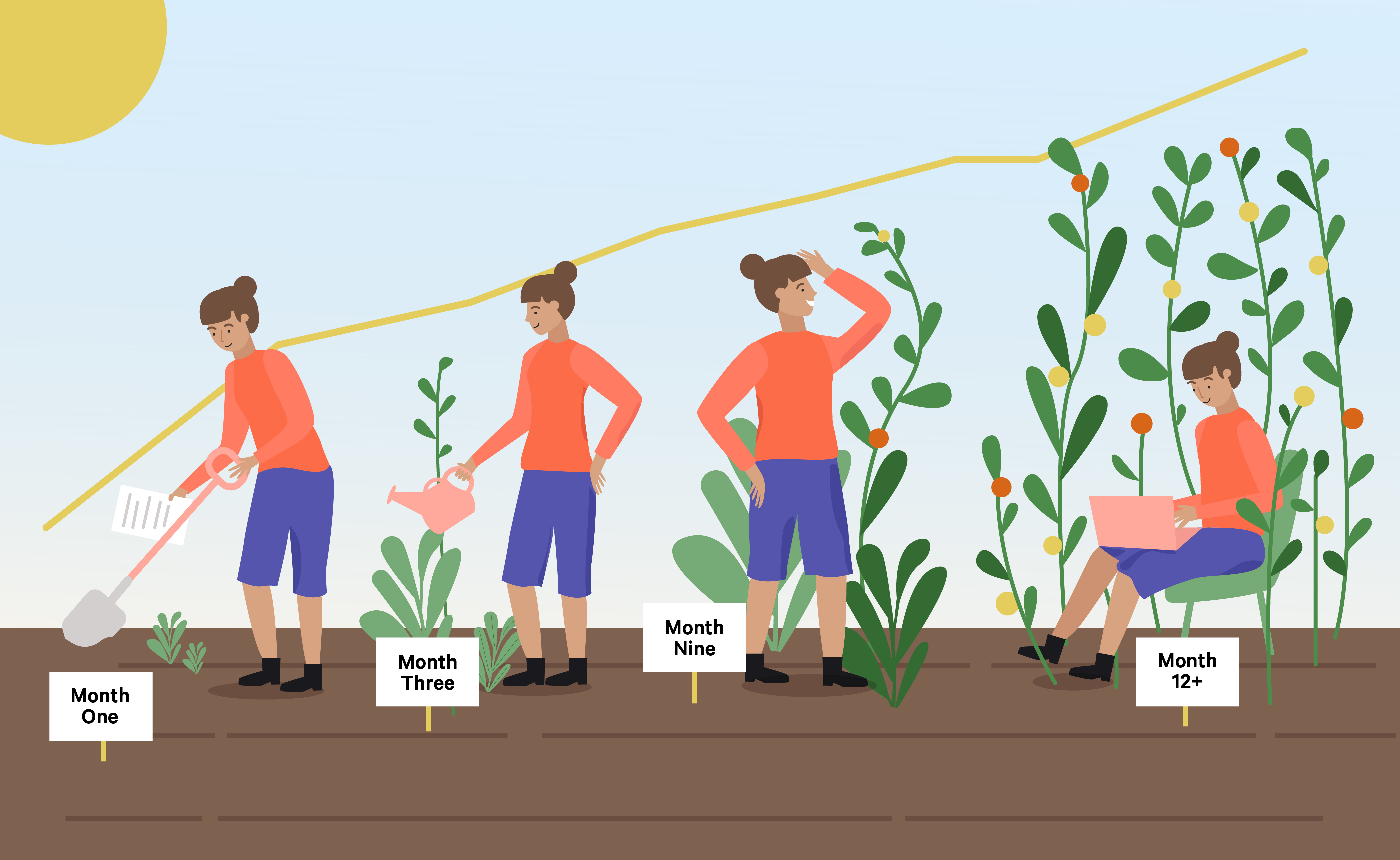
Going from 0 to 1,000 monthly organic visits often takes the same amount of time, effort, and skill as going from 1,000 to 25,000. Think about that incentive structure.
- The impatient companies will give up and lock in bad results before hitting 1,000.
- The patient and committed companies will stick it out for a few more months, and see a viable path to 25,000.
If you’re able to stick out the brutal first months on the path to 1,000 monthly organic visits, you may be just a few more months away from 25,000—and some meaningful business results.
From 600 to 6,000 Organic Visits In 12 Months
Today’s article is about a B2B technology company, a Nectafy client, whose number of organic visits skyrocketed (blogging as the main driver) in months 6-12 despite seeing minimal increases in the first six months. For us, this is a typical pattern.
The Background
This company did not have a blog before we started working together. In the month before we started (called Month 0 from here on out), the website had 588 organic visits mainly from branded keywords. In other words, they didn’t have any meaningful visibility in Google other than when the company name was searched.
The Content Output
- 62 blog articles
- Post types
- Regular (600-800 words): 33
- 2x (1200-1600 words): 22
- 3x: (1800-2400): 2
- Guest (offsite): 5
- 247 total keywords targeted (4 per post average)
The Results
|
|
Month 0 (Before Content) |
Month 12 (After Content) |
|---|---|---|
|
Domain Authority (Moz) |
18 / 100 |
33 / 100 |
|
Page 1 Keyword Rankings |
3 |
173 |
|
Blog views |
0 |
8,921 |
|
Organic sessions (visits) |
588 |
5,949 |
|
Organic contacts (leads) |
0 |
53 |
Here is the impact of content creation on keyword rankings:
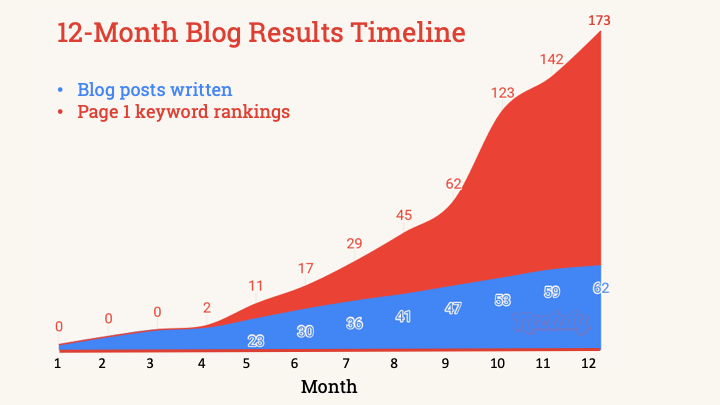
- After the first three months, we had created 15 blog posts (blue line) and returned 0 keyword rankings (red line) on page one of Google results. Frustrating.
- After six months, we’d created 30 blog posts and only returned 17 rankings. That’s progress, but we’re still underwater.
- After twelve months, we had created 62 blog posts and accumulated 173 keyword rankings.
This chart shows an important trend: Linear content creation can create exponential growth. In other words, a predictable supply of content creation can produce exponential growth if you give it time.
Here is the trend of organic visits:
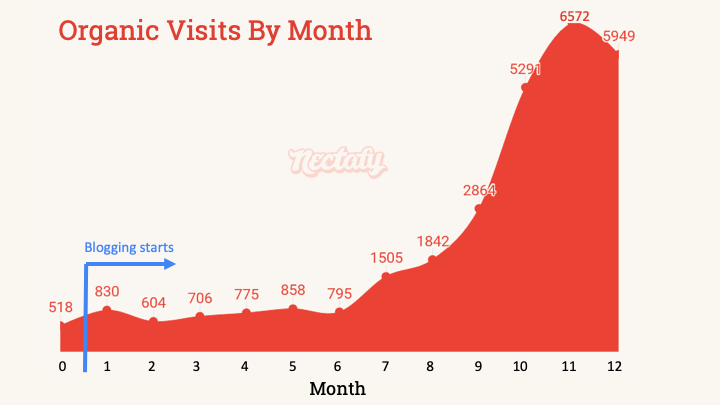
- In the first six months, visits were essentially flat (even though we had half of our yearly content completed).
- In the second six months, organic visits started skyrocketing (mainly driven from the work done in those first six months).
If we look at the twelve-month period in a different way, you can see that belief in the content program is probably most important for the first six months (or longer). It’s hard to invest time and money for six months to see no return. But if you give it twelve months, you start seeing the numbers go up and to the right.
Here is the likelihood of an individual keyword target turning into a ranking over time:
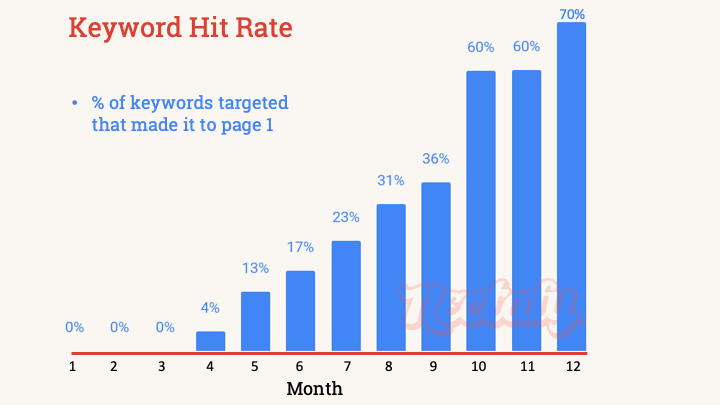
- After the first three months, we had targeted 45 keywords in our content plan and received 0 rankings (0% hit rate). It looks like things aren’t working.
- After six months, we’d targeted 100 keywords and only returned 17 rankings (17% hit rate). Finally, some movement.
- After twelve months, we’d targeted 247 total keywords and picked up 173 page one Google rankings (70% hit rate).
By putting in so much work over the first year, we’ve positioned ourselves to have a 70% likelihood of any individual keyword we go after making it onto page one. That’s a powerful tool to have.
So you’ve seen how growth content results tend to play out over 12 months of B2B blogging. Next, we’ll cover the underlying strategy that got us there.
The Strategy (How Your B2B Company Can Get These Results)
At the beginning of this article, I noted how going from 0 to 1,000 monthly organic visits was just as hard as going from 1,000 to 25,000. Because of the relative effort between those stages, Nectafy has outlined our phases of growth content in this way:
- Phase 1: Authority Building—Fewer than 1,000 visits per month and a Domain Authority of less than 20
- Phase 2: Keyword Cultivation—From 1,000–25,000 visits per month and a Domain Authority from 20 to 50
- Phase 3: Sales Growth—Greater than 25,000 visits per month and a Domain Authority from 50 to 100
These phases last for relatively similar time periods but each has different goals and strategies.
The overarching strategy we used for this B2B technology company is outlined in the phase one article. I encourage you to read that to get the full details. For this specific story, here are the highlights on a few key principles that drove the growth.
1. Prioritize keyword difficulty over search volume in the beginning.
If you are at or near 0 monthly organic visits, it means your site hasn’t built any trust with the Google algorithm. Therefore, you need to compete on search terms that few other companies are going after. You’ll receive some rankings there, then you can graduate to the more difficult ones. Here’s how it played out in this B2B case:
- In the first month, we targeted keywords with an average keyword difficulty score (a metric from SEMRush) of 19/100. That’s about as low and noncompetitive as you can find.
- By month 10-12, we were regularly targeting groups in the 40-50 range.
Match your site’s current domain authority with keyword difficulty to build growth over time.
2. Build on any rankings you get by writing about similar topics.
If you have a keyword ranking for one topic, you’re much more likely to get ranked for closely related ones. Harness this by tracking your rankings and improving your content plan by adding related topics. Here is a good example for another client that I like to highlight:
- First, we got a ranking for “how to create a Balanced Scorecard” (not a difficult keyword).
- Next, we targeted “Balanced Scorecard template” (more difficulty and many more searches).
- Finally, we targeted “Balanced Scorecard” itself (the most difficult and the most searched).
We eventually ranked for all three. But had we started with the most difficult first, we never would've had a shot.
3. Match content length and type with keyword difficulty.
At the top, we mentioned the different types of blog posts we wrote that made up the 62 total posts. The reason we have so many different post types is to match the goal of the blog post with the best-fitting post type.
Here are the general uses for the post types we mentioned above:
- Regular (600-800 word) posts: This is the normal, baseline post. It is used to target keywords we have a good chance of ranking for (lower difficulty in the beginning).
- 2x (1200-1600 word) posts: Since these are double the length of regular posts, they can be used to go after more difficult keywords than your site could normally handle. The content length (and quality—that’s important) would offset the lack of authority from your site.
- 3x: (1800-2400): This is the same principle as the 2x, with an even deeper look at the topic.
- Guest (offsite) posts: Guest posts are put on other sites with links pointing back to yours. This will help build authority for your site and can help boost specific rankings for articles that are linked to.
Zooming Out
This is a pretty typical first year for B2B clients we work with at Nectafy. If you can make it past the first six months, results start to pour in exponentially.
We cut off this story after 12 months to highlight the first year of work on growth content. From month 12 to 16, this company’s website has doubled organic again.
If you find this article useful and want to start growth content for your company, there are two ways to go:
- Read this—How To Generate Meaningful Organic Traffic To Your Website In 90 Days - to get all the highest impact strategies started in the first three months.
- Or, talk to Lance about your goals. He can point you in the right direction.
